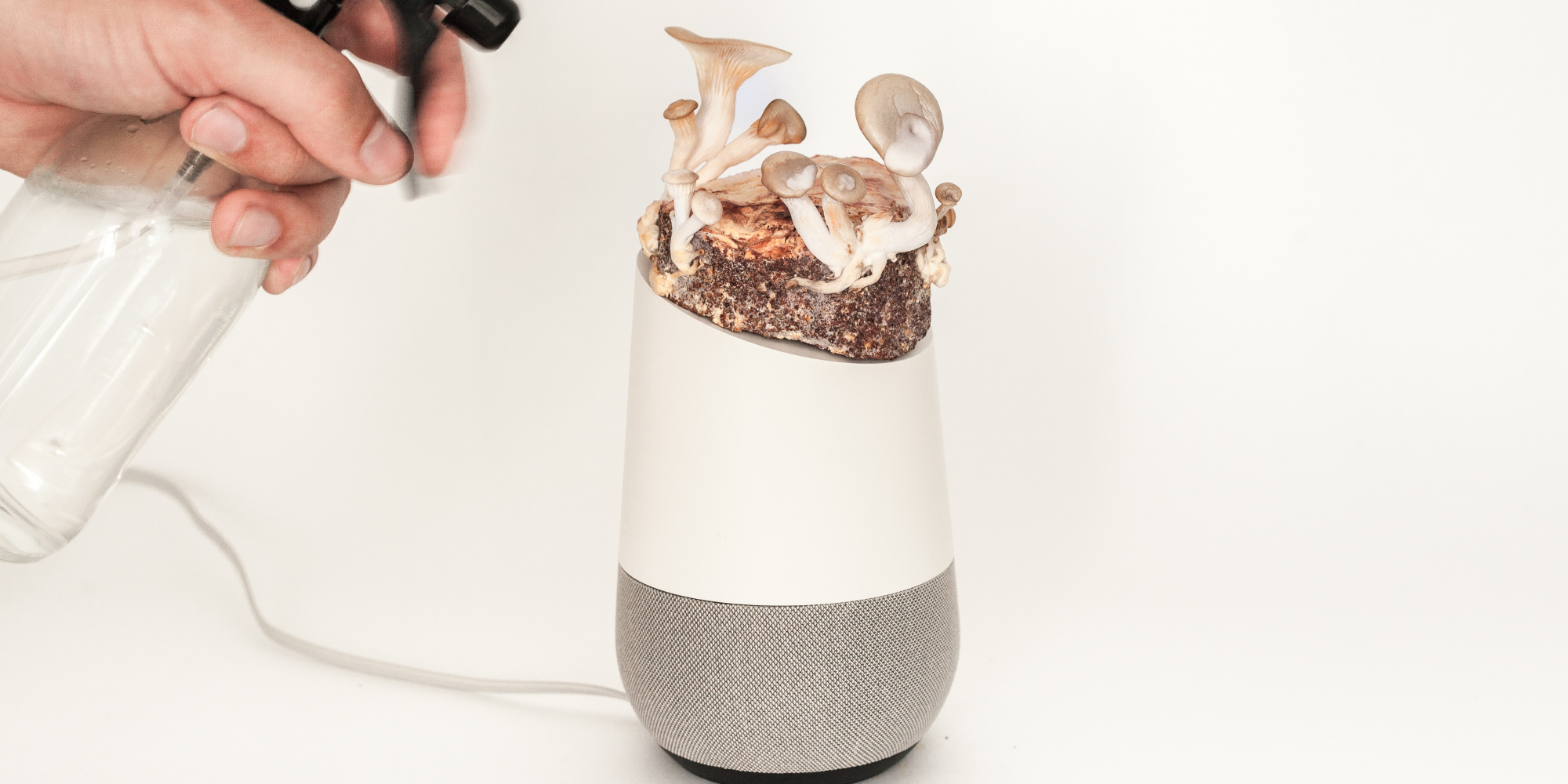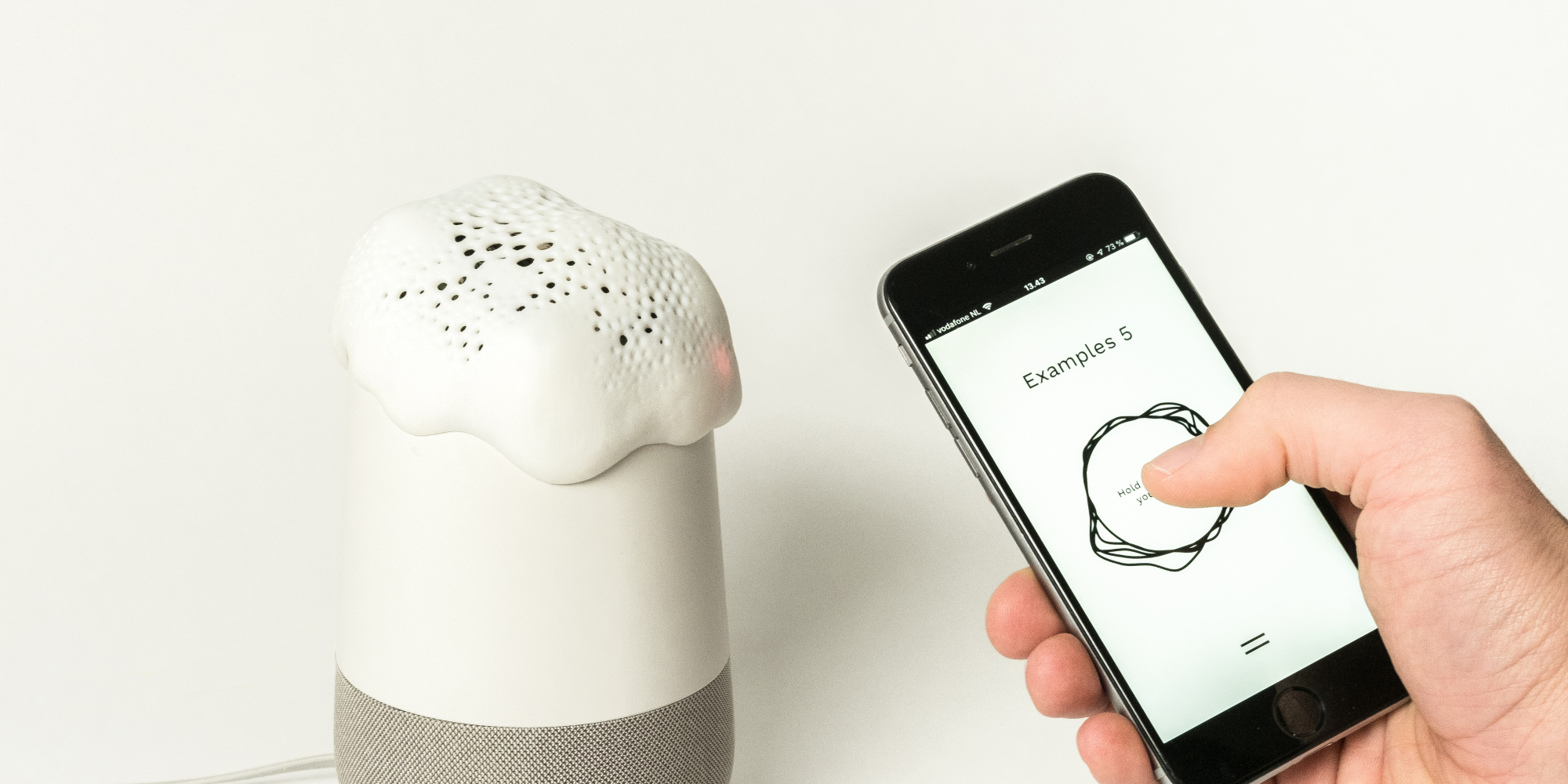Rename your home assistant and make sure it never listens.
Grand Prize – Artistic Exploration: Awarded for artistic exploration and art works where appropriation by the arts has a strong potential to influence or alter the use, deployment or perception of technology.
Alias is a teachable “parasite” that is designed to give users more control over their smart assistants, both when it comes to customization and privacy. Through a simple app, the user can train Alias to react on a custom wake word/sound and, once trained, Alias can take control over your home assistant by activating it for you. When you don’t use it, Alias will make sure the assistant is paralyzed and unable to listen by interrupting its microphones.
This makes Alias act as a middle-man device that is designed to appropriate and control voice-activated devices. Equipped with speakers and a microphone, Alias is able to communicate and manipulate the home assistant when placed on top of it. The speakers of Alias are used to interrupt the assistant with a constant low noise/sound that feeds directly into the microphone of the assistant. First, when Alias recognizes the new user-created wake word, it stops the noise and quietly activates the assistant with a sound recording of the original wake-word. From here the assistant can be used as normal. Alias is made with a Raspberry Pi that runs a small neural network locally for wake word detection. Everything is made to work locally and disconnected from the internet. Alias does also host its own Wi-Fi, which allows users to interface with it through a browser to train, reset, and turn Alias on/off.
Our relationship with technology is formed by how we interact with it. However, commercial smart products for the home tend to treat the user as passive consumers. Especially smart home assistance has shown design patterns that limit the possibilities of interaction and agency from the user perspective, even in the most private and personal sphere—the home. Our interaction patterns are highly determined by the designers of these products, and with Alias, we are interested in how this power relation can be redefined, especially when it comes to privacy. The exciting future that “smart” technologies can give us often comes with conditions that diminish our privacy and the feeling of being in control. With Alias we want to challenge this condition and ask what kind of “smart” we actually want in the future.

In order to manifest and communicate these values, we looked at how Cordyceps fungus and viruses can appropriate and control insects to fulfill their own agendas. We used this rather scary side of nature as inspiration to create our own parasite for smart home systems. This resulted in the making of Project Alias, which we see as a demonstration of how maker-culture and open source can be used to redefine our relationship with smart home technologies, by delegating more power and control from the designers/companies to the end users of the products.
Definition of “Alias”:
1. Used to indicate that a named person is also known or more familiar under another specified name.
2. Misidentify (a signal frequency), introducing distortion or error.
Credits
Bjørn Karmann is a Danish designer working at Tellart, Amsterdam. He holds a Master’s Degree in Interaction Design from the Copenhagen Institute of Interaction Design and a Bachelor’s degree in Communication Design from Kolding Design School. Graduating from CIID with highest honor, his graduation project (The Objectifier) has won multiple awards and pushed the thinking of machine learning as a means of prototyping and enriching spatial interaction. Bjørn combines his curiosity for new and emerging technologies with his passion for physical and human interactions, while finding a balance between nature and technology. With experience in design, installation art, robotics, and physical computing, he works across multiple disciplines and manifests between physical and virtual space.
Tore Knudsen born in 1992, is an Interaction designer based in Copenhagen, Denmark. He holds a Master degree in Interaction design from K3, Malmö University, and has previously worked as a digital designer. Currently, he is working as a User Experience designer at Topp Innovation & Design in Malmö, Sweden. Tore’s interest in design and technology started with photography and has expanded into many different mediums, ranging from web to physical installations. His work is often driven by an interest to explore and challenge our relationship with modern technology and he mainly does so through design and prototyping.
Jury Statement
As many domains of our private and social lives are being transfigured by new technologies of identification, monitoring, analyzing, and controlling, Karmann’s fungus-looking “parasitic” device offers a poetic yet concrete DIY intervention that allows anyone to appropriate any voice-activated appliances, thus making smart assistants less invasive. As the project title suggests, Karmann effectively uses the artistic alienation effect (“making it strange,” or defamiliarization) to make the technology different and alien to us, as something to be carefully observed, learned, and potentially changed. It is a magnificent example of turning poesis into praxis, offering a balance in conveying technology’s means of communicability while effectively changing its mediality.
Project Alias exemplifies how contemporary technologies—in this case, smart assistants—require that we open ourselves to the passive reception of the condition under which technology can be used: the user is used by the voice assistant in order to collect data about our private lives and environments. The medium is indeed the message, as McLuhan used to say, and we the users and our private data increasingly, and in some cases unintentionally, become the content of that message. Project Alias offers to flip these power relations on their head, allowing us a more reciprocal exchange: producing white noise to prevent the speaker from constantly listening or teaching it to recognize our voice to help secure our privacy.
Project Alias breathes new life into the metaphor of the parasite by turning it into an applicable political tool, hijacking a technological “host” in order to change their operations and in turn affect their relations to their surroundings. The parasitic intervention can take one of two forms: the host might do all it can to eradicate the parasite, or it might rearrange things to accommodate the needs of the parasite. In either case, the presence of the parasite means that things cannot, and will not, remain the same. Project Alias, the jury hopes, will prompt the industry to incorporate and adjust to this parasitic disturbance and provide us with transparency and control over our own technological environments.



